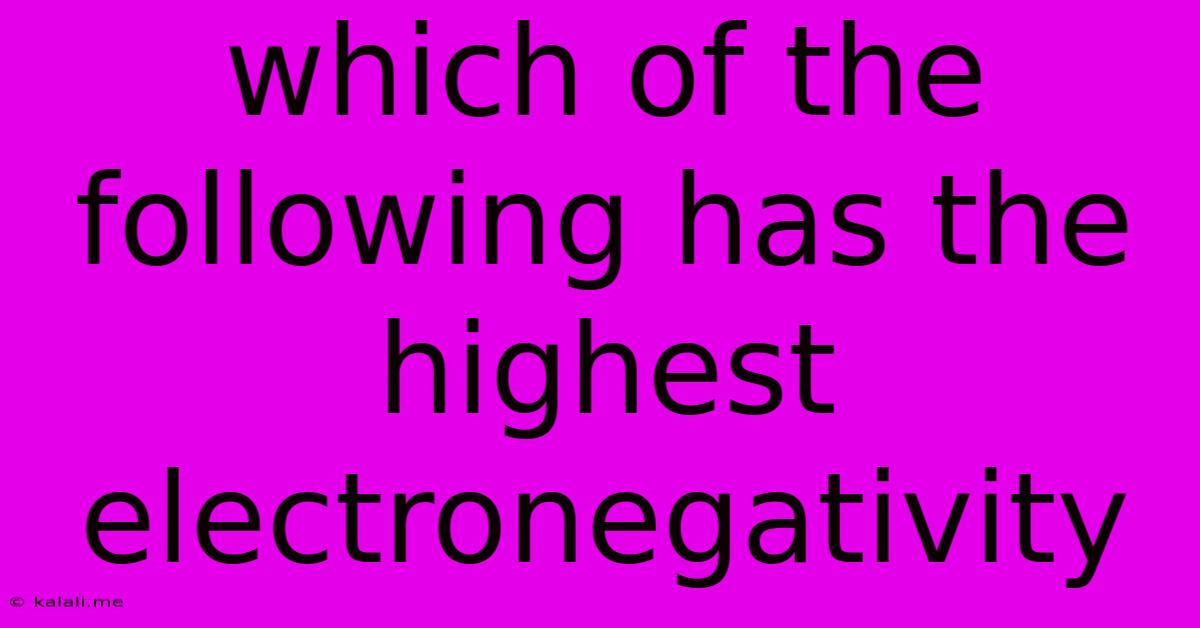Which Of The Following Has The Highest Electronegativity
Kalali
Jun 15, 2025 · 3 min read

Table of Contents
Which Element Boasts the Highest Electronegativity? Understanding Electronegativity and its Trends
Electronegativity, a fundamental concept in chemistry, describes an atom's ability to attract electrons towards itself within a chemical bond. Understanding electronegativity is crucial for predicting the nature of chemical bonds, the polarity of molecules, and overall chemical reactivity. This article will explore electronegativity, its trends in the periodic table, and definitively answer the question: which element has the highest electronegativity?
What is Electronegativity?
Electronegativity isn't a directly measurable quantity like mass or charge. Instead, it's a relative property, often represented using the Pauling scale, where values range from approximately 0.7 to 4.0. Higher values indicate a stronger ability to attract electrons. Factors influencing electronegativity include the atom's effective nuclear charge (the positive charge felt by valence electrons) and the distance of the valence electrons from the nucleus. A higher effective nuclear charge and a smaller atomic radius lead to higher electronegativity.
Periodic Trends in Electronegativity:
Electronegativity generally increases across a period (from left to right) and decreases down a group (from top to bottom) in the periodic table.
-
Across a Period: As you move across a period, the number of protons in the nucleus increases, increasing the effective nuclear charge. Since electrons are added to the same energy level, the atomic radius doesn't increase significantly. This stronger pull from the nucleus results in higher electronegativity.
-
Down a Group: As you move down a group, the number of electron shells increases, placing the valence electrons farther from the nucleus. This increased distance reduces the effective nuclear charge felt by the valence electrons, leading to lower electronegativity. The shielding effect of inner electrons also plays a crucial role.
The Element with the Highest Electronegativity:
Based on the periodic trends and various electronegativity scales, Fluorine (F) holds the title of the element with the highest electronegativity. Its position in the top right corner of the periodic table, combined with its small atomic radius and high effective nuclear charge, results in an exceptionally strong attraction for electrons.
Other Highly Electronegative Elements:
While fluorine reigns supreme, other elements also exhibit high electronegativity:
- Oxygen (O): Oxygen is another highly electronegative element, often involved in polar bonds.
- Chlorine (Cl): Chlorine, located in the same group as fluorine, also shows significant electronegativity.
- Nitrogen (N): Nitrogen exhibits considerable electronegativity, essential for its role in various biological molecules.
Applications of Electronegativity:
Understanding electronegativity is vital in numerous chemical applications:
- Predicting Bond Type: The difference in electronegativity between two atoms helps predict the type of bond they will form (ionic, covalent, or polar covalent).
- Determining Molecular Polarity: Electronegativity differences influence the distribution of charge within a molecule, determining its polarity.
- Understanding Chemical Reactivity: Electronegativity plays a significant role in determining the reactivity of elements and compounds.
In conclusion, while several elements exhibit high electronegativity, Fluorine (F) unequivocally possesses the highest value, making it a critical element in understanding chemical bonding and reactivity. By understanding the underlying principles and periodic trends, we can predict and explain the behavior of atoms and molecules in various chemical interactions.
Latest Posts
Latest Posts
-
Science Is The Systematic Study Of
Jun 15, 2025
-
Which Of The Following Particles Has The Least Mass
Jun 15, 2025
-
Which Of The Following Is Complex Sentence
Jun 15, 2025
-
University Of North Florida Sat Scores
Jun 15, 2025
-
What Is The Heat Of Hydration
Jun 15, 2025
Related Post
Thank you for visiting our website which covers about Which Of The Following Has The Highest Electronegativity . We hope the information provided has been useful to you. Feel free to contact us if you have any questions or need further assistance. See you next time and don't miss to bookmark.